 |
DEPARTMENT
RESULTS |
|
|
| |
|
Goal:
Fostering community partnerships
|
|
Why is this goal important?
Partnerships impact delivery of correctional services and promote safety
in correctional facilities and the community. The work of the Department of
Corrections (DOC) is dependent on many community partnerships: with law
enforcement, local and county corrections entities, direct-care providers,
offenders and their families, and communities. By working together,
resources may be better targeted to reduce offender recidivism, increase
public safety, and contribute toward healthier communities.
How will this goal be accomplished?
The DOC is exploring new ways to utilize community partnerships to
impact public safety. One example is offender transition from incarceration
to the community, which accesses resources of numerous state agencies and
community providers. At the Governor’s direction, the Commissioner of
Corrections convened state agency representatives to collaborate on
implementation of a statewide reentry initiative, the Minnesota
Comprehensive Offender Reentry Plan (MCORP). The plan includes a
demonstration project involving Hennepin, Ramsey, and Olmsted Counties.
The DOC has actively partnered with
corrections professional organizations such as the Minnesota Corrections
Association, the Minnesota Association of Community Corrections Act
Counties, the Minnesota Community Corrections Association, the Minnesota
Association of County Probation Officers, and others. These partnerships are
evident in the involvement of Minnesota’s three correctional delivery
systems in development of evidence-based best practices, community forums,
professional training, and policy development.
In addition to collaborating with local
law enforcement to apprehend fugitives, the peace officers in the DOC Office
of Special Investigations (OSI) Fugitive Apprehension Unit investigate,
locate, and arrest fugitives. OSI also provides intelligence information to
local law enforcement. 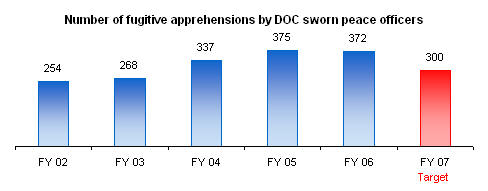 Behind-the-scenes
efforts supported by the DOC include entering data on warrants issued into
the NCIC database. Warrants are then entered into the law enforcement
viewer, and the most-wanted fugitives are posted on the department website. Behind-the-scenes
efforts supported by the DOC include entering data on warrants issued into
the NCIC database. Warrants are then entered into the law enforcement
viewer, and the most-wanted fugitives are posted on the department website.
Productive work assignments are continued in the community by:
Sentencing to Service (STS): Carefully
selected, non-violent offenders sentenced by the court to work on community
improvement projects in combination with jail time, or as a probation
sanction. Started in 1986, about 30,000 offenders participate in STS
annually across the state, working over one million hours.
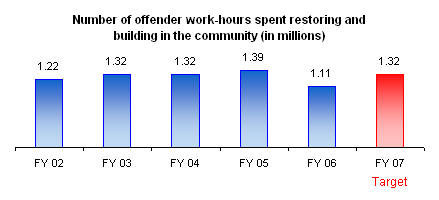
Institution/Community Work Crews (ICWC):
Carefully screened, minimum-security, adult male state prison inmates from
Faribault, Lino Lakes, Red Wing, and Stillwater. An average of 120 ICWC
offenders perform work service daily. An additional 40 ICWC offenders
construct affordable housing in greater Minnesota through the ICWC
Afford-able Homes Program.
Offenders learn new
social and work skills on crews that restore communities through a variety
of projects including: fire containment, flood and storm damage control,
trail and waterway development, construction, and land restoration.


What is the DOC progress to date?
The DOC is aggressively pursuing alternative funding (federal
grants, etc.) for more resources to expand investigative efforts leading to
apprehension of DOC-warranted sex offenders,
most-wanted fugitives, and DOC-warranted gang members.
Eight state agencies, along with state courts
administration, have recently begun a state-wide reentry initiative, the
Minnesota Comprehensive Offender Reentry Plan (MCORP).
The ICWC Affordable Homes Program began in 1998.
Through FY07, over 250 homes have been built.
|
|
Learn more at:
 Sentencing to Service Brochure
Sentencing to Service Brochure
http://www.doc.state.mn.us/org/communityserv/documents/stsbrochure-Dec06.pdf
 ICWC Affordable Homes Publication
http://www.doc.state.mn.us/org/communityserv/documents/ICWCAHP01.07.pdf
ICWC Affordable Homes Publication
http://www.doc.state.mn.us/org/communityserv/documents/ICWCAHP01.07.pdf
|
|
Goal:
Optimizing best practices |
|
Why is this goal important?
The mission of the DOC is to contribute to a safer
Minnesota. This is done through offender management within correctional
facilities and under supervision in the community. Recidivism, or an
offenders’ rate of return to correctional custody for a new crime(s), is a key
performance measure of community safety.
The DOC believes that evidence-based best
practices are the gold standard for corrections programs affecting
recidivism. These best practices are an integral component in many areas of
the DOC. One way to
promote the use of evidence-based services throughout the state is by
including the use of gender and culture-appropriate programming in
department initiatives.
How will this goal be accomplished?
Successful
transition from incarceration to the community is a critical factor in
recidivism and a high priority for the department. Every offender
who transitions from incarceration to the community affects the quality of
life for all citizens. Reentry planning is designed to provide offenders
with information on and prepare them for housing, employment, medical
services, and treatment support within the community. Reentry activities
include: pre-release classes, job fairs, family law workshops, transition
fairs, child support work-shops, and library transition resource centers.
What is the DOC
progress to date?
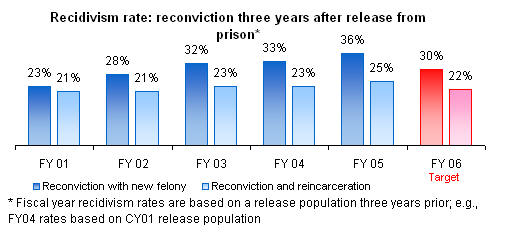
In a three year follow-up study, just over one-third (36 percent) of all
adult offenders released from a Minnesota prison were convicted of a new
felony. Offenders returning to prison with a new felony commitment
within those same three years totaled 25 percent.
Resources are available at all DOC
facilities to assist offenders in securing housing and employment, pursuing
educational opportunities, obtaining personal ID documents, maintaining
physical and mental health, establishing sound personal finances, obtaining
transportation, and family reunification.
DOC transition staff partner with a wide
variety of community organizations and businesses offering job fairs,
transition resource fairs, family law clinics, child support workshops,
employment preparation workshops, and pre-release classes to offenders at
DOC facilities.
In an effort to cultivate
relationships with employers statewide, a recent initiative was begun to
create working relationships with employers statewide. The goal of this
initiative is maximizing successful placement of offenders in meaningful
employment in the community.
|
|
Learn more at:
 Department of Justice study on recidivism
Department of Justice study on recidivism
www.ojp.usdoj.gov/bjs/pub/pdf/rpr94.pdf
 DOC Biennial Performance report
http://www.doc.state.mn.us/publications/legislativereports/documents/PerformanceReport200601-31-07.pdf
DOC Biennial Performance report
http://www.doc.state.mn.us/publications/legislativereports/documents/PerformanceReport200601-31-07.pdf
 DOC 2006 Outcome Evaluation of the Challenge Incarceration Program
http://www.doc.state.mn.us/publications/documents/CIPEvaluationReport10-06.pdf
DOC 2006 Outcome Evaluation of the Challenge Incarceration Program
http://www.doc.state.mn.us/publications/documents/CIPEvaluationReport10-06.pdf
 Sex Offender Recidivism in Minnesota
Sex Offender Recidivism in Minnesota
http://www.doc.state.mn.us/publications/documents/04-07SexOffenderReport-Recidivism.pdf
 Residential Proximity & Sex Offense Recidivism in Minnesota
Residential Proximity & Sex Offense Recidivism in Minnesota
http://www.doc.state.mn.us/documents/04-07SexOffenderReport-Proximity.pdf
|
| |
|
Goal:
Creating a respectful,
diverse culture |
|
Why is this goal important?
Agency administration values the contributions and hard work of staff and
believes it is important to provide a work environment free from harassment
and to encourage employee participation in mediation processes to resolve
conflicts. Employees share the responsibility for creating and maintaining
an environment free of harassment. To better serve the disproportionate
number of minority offenders in the criminal justice system, recruiting and
retaining a diverse workforce is a priority for the department.
How will this goal be accomplished?
A recent workplace planning initiative identified mission critical
occupations that will be impacted by retirements, separations, and turnover.
As part of this DOC overall workplace planning project, an agency Strategic
Recruitment Plan was developed. Recruitment survey data and recruitment
methods of other organizations and corrections agencies were analyzed,
resulting in several recommendations:
■ Establish a centralized DOC recruitment
program
■ Increase the diversity of the applicant pool so that under-represented
groups can be better represented in our workforce
■ Implement flexible recruitment strategies as needs are identified
■ Conduct ongoing evaluations using identified recruitment performance
measures
■ Sustain an adequate budget for aggressive recruitment efforts
What is the DOC
progress to date?
■ Affirmative action manager: In an effort to raise the visibility and
commit sufficient resources to affirmative action and diversity functions, a
Management Plan position was reestablished and filled in March 2006
■ Recruitment position: The affirmative action manager hired a recruiter to
assure focus on protected group members
■ Recruitment Plan (coordinated from central office for all DOC locations):
A plan was designed, funded, and implemented in 2004 to coordinate all
recruitment activities
■ Standardized recruitment materials: Accomplished in 2004 for
department-wide use
■ Training for recruitment teams: Provided annually
■ Minority recruitment: Modification to the existing recruitment plan will
focus on reaching minority applicants
■ Diversity: In August 2003, the African American Employment Task Force
began an examination of current policies and practices relating to
employment. As a result of the work of the task force, significant
improvements have been made in the department’s employment policies and
practices for all employees
■ Quarterly reports on progress toward affirmative action goals: Since April
2005, all managers have been provided quarterly updates on their progress
toward meeting affirmative action goals ■ Format for missed
opportunity requests: In 2005, stricter reporting requirements were
instituted department-wide. This new format is intended to ensure that all
applicants are compared on the same knowledge, skills, and abilities
■ Retention Strategy Plan: In 2006, agency retention plan strategies were
developed and are being implemented
■ Conflict Resolution Initiative: In 2003, the Conflict Resolution
Initiative was approved as a department-wide dispute resolution tool. In
February 2006, DOC policy was established. Annual staff surveys measure
effectiveness |
|
|
|
|
Goal:
Utilizing effective
communication |
|
Why is this goal important?
For any program or agency to be successful in achieving
strategic goals, it is critical to keep stakeholders informed, involved in
establishing program goals, and actively partnered with the DOC toward
accomplishment of mutual goals.
How will this goal be accomplished?
The DOC regularly communicates with and
solicits feedback from internal and external
stakeholders through focus groups, surveys, task forces, work groups,
seminars, and public forums.
Staff strives to provide information and education
to the public, media, and policymakers in all branches of government to
ensure a thorough understanding of the purpose and scope of the DOC.
Increasing understanding of agency responsibilities positively impacts
public safety, policy, and allocation of resources.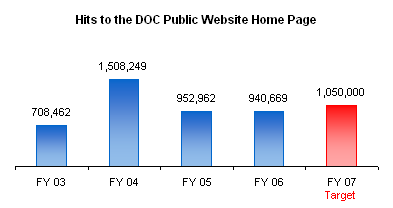
The department provides historical reports, analysis, presentations and other documents on the DOC
website. In addition to making these documents available
to the public, access on the website reduces state
employee time and state copying/mailing expenditures formerly necessary to
distribute these reports to the public.
The department also provides online access to policies
and procedures. This creates efficiencies within the system as well as
providing access to non-DOC stakeholders.
What is the DOC
progress to date?
Hits to the department’s home page increased
dramatically between FY03 and FY04, more than doubling during this time
period and reaching an unprecedented high of 1.5 million hits. Department
officials surmise that this dramatic increase resulted from community
interest in a highly-publicized crime. The number of hits declined in FY05,
but still reached nearly a million in both FY05 and FY06. This figure is
expected to increase gradually over time, barring another incident that
might garner a high degree of public interest.
The department has implemented sharepoint software
services on the DOC employee intranet site, greatly enhancing internal
communications. The DOC is considering expanding sharepoint services into
the public website, which would allow commit-tees/groups/task forces to
share minutes, handouts, etc.
|
|
Goal:
Strategic use of resources
|
|
Why is this goal important?
The department continues to plan for an increasing prison population,
based on projections determined by the agency and the Sentencing Guidelines
Commission. Minnesota has been able to manage its increasing population
through expansion at existing facilities and construction of a new facility
that opened in 2000. Future expansions will be brought on at significantly
reduced costs.
Learn more at:
 DOC 2007 Population Projections Report
DOC 2007 Population Projections Report
http://www.doc.state.mn.us/publications/documents/FY07PrisonPopulationProjectionsReport.pdf
 DOC Prison Population Projections Backgrounder
http://www.doc.state.mn.us/publications/backgrounders/documents/Projections2007.pdf
DOC Prison Population Projections Backgrounder
http://www.doc.state.mn.us/publications/backgrounders/documents/Projections2007.pdf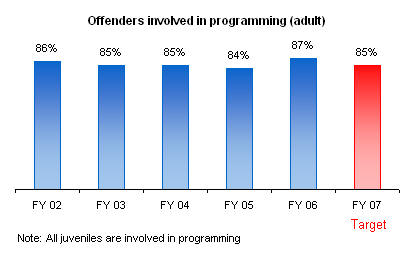
Programming is an integral part of preparing offenders
for eventual release to the community. It also reduces inmate idleness,
contributing to operating prisons that are relatively safe and free of
violence.
The department recognizes that employee injuries are
unacceptable losses that negatively impact the organization. While much has
been done to standardize, plan, and improve the safety performance at each
facility, it is important to continue to look for system improvements that
can lead to fewer losses of human and fiscal resources.
The department has also begun implementing quality
improvement strategies with staff attending Six Sigma and Lean training.
These training sessions introduced management tools for reducing errors and
streamlining work processes.
How will this goal be accomplished?
 To
bring on new beds at marginal per diems, the department considers public and
staff safety, in addition to cost efficiencies. Along with annual reviews of
facility budgets and spending plans, annual staff deployment reviews at
facilities will be part of the ongoing effort to address per diems. To
bring on new beds at marginal per diems, the department considers public and
staff safety, in addition to cost efficiencies. Along with annual reviews of
facility budgets and spending plans, annual staff deployment reviews at
facilities will be part of the ongoing effort to address per diems.
Many inmates enter prison lacking basic job skills and work habits. Through
MINNCOR, offenders learn marketable job skills and develop sound work
ethics. The challenge is to cultivate the market, and diversify the customer
base sufficient to continually generate more inmate assignments. Strategies
include increasing the number of private-company partnerships and increasing
the activities within the public sector.
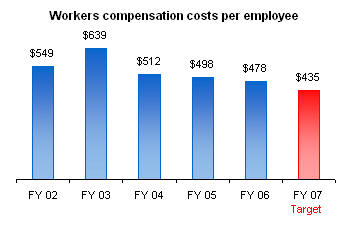
Increasing
offenders’ level of educational achievement during incarceration is an
integral part of preparing offenders for release and transition back into
their communities. Offenders undergo educational testing at intake. Those offenders who enter a state correctional facility with less than a GED/12th
grade education and who have a period of incarceration longer than one year
are included in a literacy target group.
Assessing the safety culture of all facilities to identify potential system
improvements will continue in an attempt to reduce injuries and their
associated losses while positively impacting morale, attitudes, and
behaviors. An employee safety culture survey has been completed and the
results discussed with employee focus groups at each facility and in field
services. A follow-up survey will be administered in 2007 to assess
improvements.
Work teams have completed training in quality
improvement and applied learned techniques to specific projects. Additional
work teams will complete training during the fiscal year.
What is the DOC
progress to date?
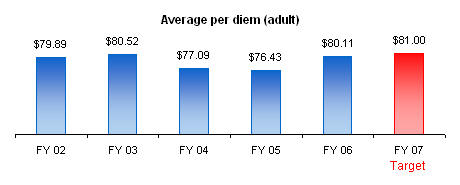
■ Per diems: The per diem rose in FY06 for the first time in several years.
The increase is due largely to rising health care costs, the need to rent
high-cost beds, and inflation.
■ MINNCOR: MINNCOR employs approximately 15% of the inmate population (more
than twice the national average).
■ Education: Approximately 5,500 offenders participate in facility literacy
programs, while over 7,100 offenders will participate in educational
programming during any given year. During FY06, 607 GEDs and high school
diplomas were awarded.
■ Safety:
 Improvement plans, based on the results
of the safety culture survey, were developed with Improvement plans, based on the results
of the safety culture survey, were developed with
specific steps to be
implemented at each work location. Plans focused on four main areas:
Improved communication, supervisor and management visibility and support,
increased
access to safety-related communication, and employee participation
and recognition.
 Training has been conducted at every
facility and location. Safety Leadership Teams are Training has been conducted at every
facility and location. Safety Leadership Teams are
being developed at every
facility to help guide improvement strategies and ensure
completion of
initiatives.
■ Quality improvement: Projects have demonstrated success in improved
efficiency in MINNCOR, streamlining payroll processes, and reducing facility
linen costs.
|
|
Learn more at:
 www.minncor.com
www.minncor.com |
| |
|
Last update on
07/20/2007 |
|


 Behind-the-scenes
efforts supported by the DOC include entering data on warrants issued into
the NCIC database. Warrants are then entered into the law enforcement
viewer, and the most-wanted fugitives are posted on the department website.
Behind-the-scenes
efforts supported by the DOC include entering data on warrants issued into
the NCIC database. Warrants are then entered into the law enforcement
viewer, and the most-wanted fugitives are posted on the department website.



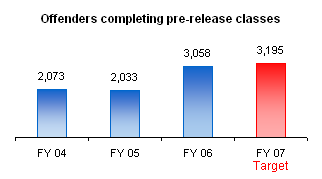
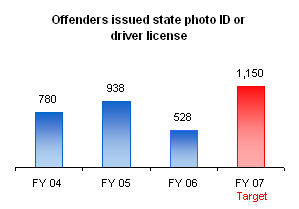


 To
bring on new beds at marginal per diems, the department considers public and
staff safety, in addition to cost efficiencies. Along with annual reviews of
facility budgets and spending plans, annual staff deployment reviews at
facilities will be part of the ongoing effort to address per diems.
To
bring on new beds at marginal per diems, the department considers public and
staff safety, in addition to cost efficiencies. Along with annual reviews of
facility budgets and spending plans, annual staff deployment reviews at
facilities will be part of the ongoing effort to address per diems.
